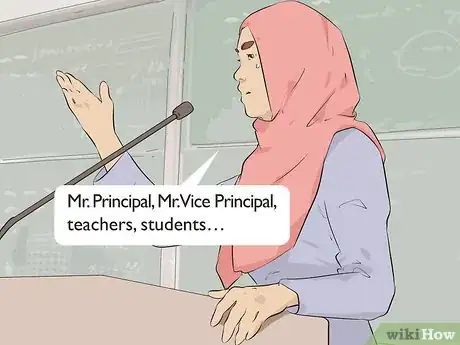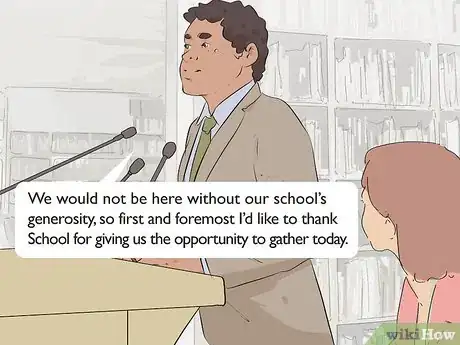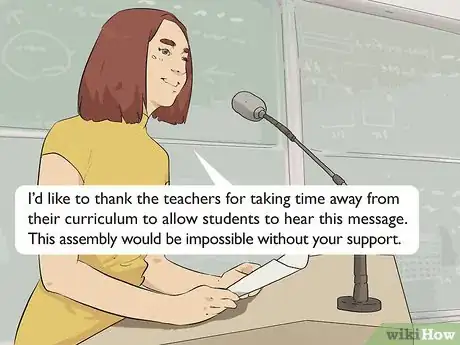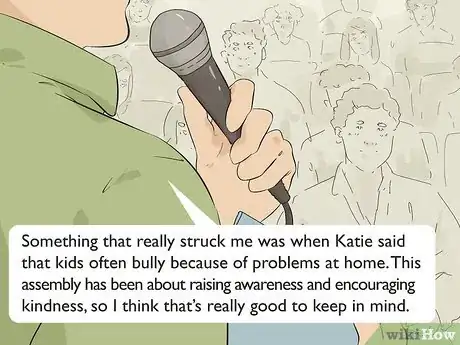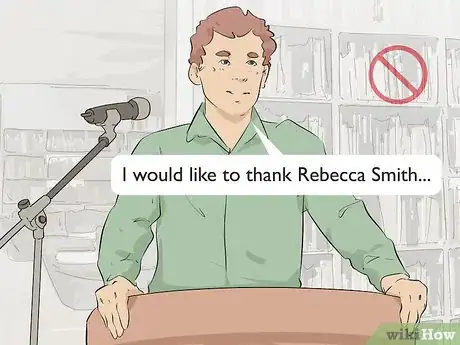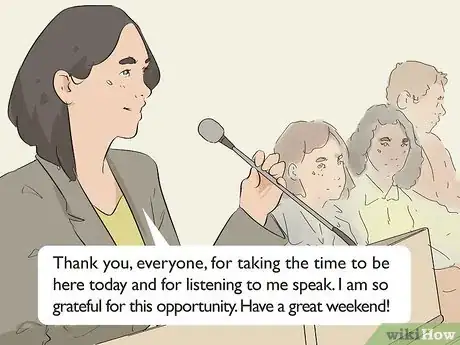This article was co-authored by wikiHow Staff. Our trained team of editors and researchers validate articles for accuracy and comprehensiveness. wikiHow's Content Management Team carefully monitors the work from our editorial staff to ensure that each article is backed by trusted research and meets our high quality standards.
wikiHow marks an article as reader-approved once it receives enough positive feedback. In this case, 91% of readers who voted found the article helpful, earning it our reader-approved status.
This article has been viewed 243,890 times.
Learn more...
No event comes together without the support of a vast network of people. If you've been asked to give a vote of thanks at the end of a seminar, council, cultural summit, or similar gathering, it's your job to show appreciation on behalf of the organization for everyone who helped make the event a reality. Start with a strong opening statement, thank your audience quickly and engagingly, and then conclude your speech.
Steps
Making an Opening Statement
-
1Address the people you will thank in your speech. Many people begin their vote of thanks with a nod to the members of the audience they are about to thank. Your first sentence should let your audience know you're speaking to them and make them feel included in your thanks.
- Opening lines like this one may sound pretty familiar: “Friends, Romans, countrymen…” Alter it slightly to suit your situation; you might end up with something like, “Mr. Principal, Mr. Vice Principal, teachers, students…”.[1]
-
2Introduce yourself and your role. If you haven't already given your name, now is a good time! Tell your audience you've been asked to give a vote of thanks, and in 1 or 2 sentences, explain your relation to the organization. You might also include your role in the event.
- For example: “My name is Jane Doe, chairman of the School Anti-Bullying Committee. I hope you've all enjoyed the informative assembly our committee organized for you today. It is my honor and privilege now to give a vote of thanks to all those who helped make this assembly happen.”
Advertisement -
3Acknowledge the organization that brought everyone together. Every person in the room is likely to have some affiliation with the overarching organization, so before you move into the body of your speech, it's nice to start with gratitude toward your host.[2]
- E.g.: “We would not be here without our school's generosity, so first and foremost I'd like to thank School for giving us the opportunity to gather today.”
Writing the Body of Your Speech
-
1Identify the people you want to thank. This list usually consists of guests, participants, organizers, volunteers, and sponsors.[3] Before you deliver your speech, determine the people and groups you'd like to give shout-outs to so that when the moment comes, you don't forget anyone.[4]
- Everyone, no matter their role in the event, wants to feel that they played an important part. Whether you are thanking someone for their time or for other support, emphasize the importance of their contribution to the big picture.
- For example: “I'd like to thank the teachers for taking time away from their curriculum to allow students to hear this message. This assembly would be impossible without your support.”
-
2Try not to gush. Gratitude is most effective when it is sincere. Avoid letting a thank-you drag on, and don't exaggerate your thankfulness: you'll bore your audience and off-put the person you're thanking. Keep each thank-you brief, warm, and honest.[5]
- Instead of, “Mr. Phillips, I cannot thank you enough for letting us use your room to practice. Your generosity and kindness toward our committee has been overwhelming, and we would be nothing without you,” try: “Mr. Phillips, our committee is so grateful to you for letting us use your classroom to practice when we had nowhere else.”
-
3Call back to a specific moment from the event and respond to it. Show performers/speakers that you were actively listening by referencing something they said that stuck with you. In a few sentences, mention an idea a participant brought up and point out its relevance to the event's overall themes.[6]
- Pick something you liked and agreed with. Don't bring up anything to disagree with it: you want to speak purely positively.
- For example: “Something that really struck me was when Katie said that kids often bully because of problems at home. This assembly has been about raising awareness and encouraging kindness, so I think that's really good to keep in mind.”
Concluding Your Vote of Thanks
-
1Underscore your organization's value. At the end of your speech, talk about what makes your organization special. You might lay emphasis on the ways it helps your community, large or small. You want people to leave your event having positive associations with your group.
- For instance: “I would like to thank everyone who helped our committee make this anti-bullying assembly a reality. We are trying to make our halls a safe, friendly space for all students who walk down them, and it's events like these that help us achieve that.”
-
2Refrain from thanking specific individuals at the end of your speech. Ideally, any specific individuals who deserve recognition will have already been thanked in the body of your speech. As you're wrapping up, try to speak generally, addressing your entire audience—don't alienate anybody with name-dropping.[7]
-
3Keep your vote of thanks short. It's a good idea to keep your entire vote of thanks short and simple, but it's never more important than at the conclusion. It's the end of the event and your audience doesn't want to be kept waiting. Be considerate of their time and limit what you say to what needs to be said.
- To close out your speech, you might say: “Thank you, everyone, for taking the time to be here today and for listening to me speak. I am so grateful for this opportunity. Have a great weekend!”
References
- ↑ https://www.folgerdigitaltexts.org/html/JC.html
- ↑ http://www.myspeechclass.com/vote-of-thanks-examples.html
- ↑ https://www.toppr.com/guides/speech-for-students/vote-of-thanks-speech/
- ↑ http://www.myspeechclass.com/vote-of-thanks-examples.html
- ↑ https://www.streetdirectory.com/travel_guide/15756/writing/a_vote_of_thanks___the_dos_and_do_nots.html
- ↑ https://www.streetdirectory.com/travel_guide/15756/writing/a_vote_of_thanks___the_dos_and_do_nots.html
- ↑ https://byjus.com/english/vote-of-thanks-speech-in-english/
